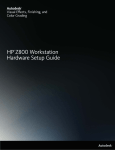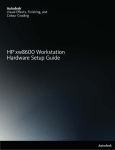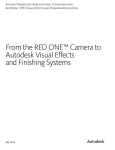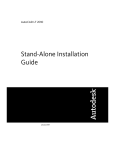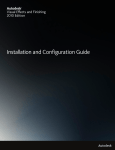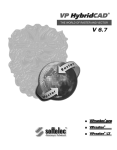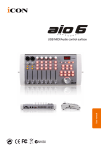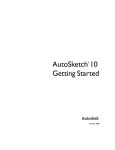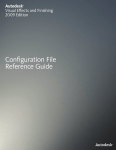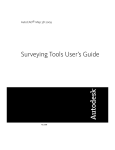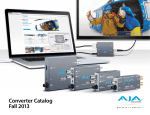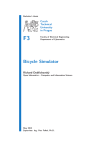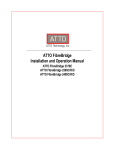Download "user manual"
Transcript
Autodesk Visual Effects, Finishing, and Color Grading ® HP Z800 Workstation Hardware Setup Guide ® Autodesk® Visual Effects, Finishing and Grading 2010 © 2009 Autodesk, Inc. All rights reserved. Except as otherwise permitted by Autodesk, Inc., this publication, or parts thereof, may not be reproduced in any form, by any method, for any purpose. Certain materials included in this publication are reprinted with the permission of the copyright holder. Portions relating to MD5 Copyright © 1991-2, RSA Data Security, Inc. Created 1991. All rights reserved. License to copy and use this software is granted provided that it is identified as the "RSA Data Security, Inc. MD5 Message-Digest Algorithm" in all material mentioning or referencing this software or this function. License is also granted to make and use derivative works provided that such works are identified as "derived from the RSA Data Security, Inc. MD5 Message-Digest Algorithm" in all material mentioning or referencing the derived work. RSA Data Security, Inc. makes no representations concerning either the merchantability of this software or the suitability of this software for any particular purpose. It is provided "as is" without express or implied warranty of any kind. These notices must be retained in any copies of any part of this documentation and/or software. Trademarks The following are registered trademarks or trademarks of Autodesk, Inc., and/or its subsidiaries and/or affiliates in the USA and other countries: 3DEC (design/logo), 3December, 3December.com, 3ds Max, ADI, Algor, Alias, Alias (swirl design/logo), AliasStudio, Alias|Wavefront (design/logo), ATC, AUGI, AutoCAD, AutoCAD Learning Assistance, AutoCAD LT, AutoCAD Simulator, AutoCAD SQL Extension, AutoCAD SQL Interface, Autodesk, Autodesk Envision, Autodesk Intent, Autodesk Inventor, Autodesk Map, Autodesk MapGuide, Autodesk Streamline, AutoLISP, AutoSnap, AutoSketch, AutoTrack, Backburner, Backdraft, Built with ObjectARX (logo), Burn, Buzzsaw, CAiCE, Can You Imagine, Character Studio, Cinestream, Civil 3D, Cleaner, Cleaner Central, ClearScale, Colour Warper, Combustion, Communication Specification, Constructware, Content Explorer, Create>what's>Next> (design/logo), Dancing Baby (image), DesignCenter, Design Doctor, Designer's Toolkit, DesignKids, DesignProf, DesignServer, DesignStudio, Design|Studio (design/logo), Design Web Format, Discreet, DWF, DWG, DWG (logo), DWG Extreme, DWG TrueConvert, DWG TrueView, DXF, Ecotect, Exposure, Extending the Design Team, Face Robot, FBX, Fempro, Filmbox, Fire, Flame, Flint, FMDesktop, Freewheel, Frost, GDX Driver, Gmax, Green Building Studio, Heads-up Design, Heidi, HumanIK, IDEA Server, i-drop, ImageModeler, iMOUT, Incinerator, Inferno, Inventor, Inventor LT, Kaydara, Kaydara (design/logo), Kynapse, Kynogon, LandXplorer, Lustre, MatchMover, Maya, Mechanical Desktop, Moldflow, Moonbox, MotionBuilder, Movimento, MPA, MPA (design/logo), Moldflow Plastics Advisers, MPI, Moldflow Plastics Insight, MPX, MPX (design/logo), Moldflow Plastics Xpert, Mudbox, Multi-Master Editing, NavisWorks, ObjectARX, ObjectDBX, Open Reality, Opticore, Opticore Opus, Pipeplus, PolarSnap, PortfolioWall, Powered with Autodesk Technology, Productstream, ProjectPoint, ProMaterials, RasterDWG, Reactor, RealDWG, Real-time Roto, REALVIZ, Recognize, Render Queue, Retimer,Reveal, Revit, Showcase, ShowMotion, SketchBook, Smoke, Softimage, Softimage|XSI (design/logo), Sparks, SteeringWheels, Stitcher, Stone, StudioTools, Topobase, Toxik, TrustedDWG, ViewCube, Visual, Visual Construction, Visual Drainage, Visual Landscape, Visual Survey, Visual Toolbox, Visual LISP, Voice Reality, Volo, Vtour, Wire, Wiretap, WiretapCentral, XSI, and XSI (design/logo). Adobe, Flash and Reader are either trademarks or registered trademarks in the United States and/or countries. Automatic Duck and the duck logo are trademarks of Automatic Duck, Inc. FFmpeg is a trademark of Fabrice Bellard, originator of the FFmpeg project. Python is a registered trademark of Python Software Foundation. All other brand names, product names or trademarks belong to their respective holders. Disclaimer THIS PUBLICATION AND THE INFORMATION CONTAINED HEREIN IS MADE AVAILABLE BY AUTODESK, INC. “AS IS.” AUTODESK, INC. DISCLAIMS ALL WARRANTIES, EITHER EXPRESS OR IMPLIED, INCLUDING BUT NOT LIMITED TO ANY IMPLIED WARRANTIES OF MERCHANTABILITY OR FITNESS FOR A PARTICULAR PURPOSE REGARDING THESE MATERIALS. Published by: Autodesk, Inc. 111 Mclnnis Parkway San Rafael, CA 94903, USA Title: Autodesk Visual Effects, Finishing, and Colour Grading HP Z800 Workstation Hardware Setup Guide Document Version: 1 Date: August 28, 2009 Contents Chapter 1 Introduction . . . . . . . . . . . . . . . . . . . . . . . . . . . . . . . . . . . . . . . . . . . 1 About This Guide . . . . . . . Related Documentation . . . . Notation Conventions . . . . Contacting Customer Support Chapter 2 Getting . . . . . . . . . . . . . . . . . . . . . . . . . . . . . . . . . . . . . . . . . . . . . . . . . . . . . . . . . . . . . . . . . . . . . . . . . . . . . . . . . . . . . . . . . . . . . . . . . . . . . . . . . . . . . . . . . . . . . . . . . . . . . . . . . . . . . . . . . . . . . . . . . . . . .1 .1 .2 .2 Started . . . . . . . . . . . . . . . . . . . . . . . . . . . . . . . . . . . . . . . . . 3 General Workflow . . . . . . . . . . . . . . . . . . . . . . . . . . . Typical Configuration Overview for Autodesk Effects and Finishing Typical Configuration Overview for Autodesk Lustre . . . . . . . . Hardware Configuration Guidelines . . . . . . . . . . . . . . . . . Memory Requirements . . . . . . . . . . . . . . . . . . . . . Ensuring Proper Environmental Conditions . . . . . . . . . . Power and Air Conditioning Requirements . . . . . . . . . . Rack Mount Requirements . . . . . . . . . . . . . . . . . . . Avoiding Damage from Static Electricity . . . . . . . . . . . . Grounding Audio Hardware Components . . . . . . . . . . . Receiving Your Shipment . . . . . . . . . . . . . . . . . . . . Chapter 3 . . . . Connecting . . . . . . . . Applications . . . . . . . . . . . . . . . . . . . . . . . . . . . . . . . . . . . . . . . . . . . . . . . . . . . . . . . . . . . . . . . . . . . . . . . . . . . . . . . . . . . . . . . . . . . . . . . . . . . . . . . . . . . . . . . . . . . . . . . . . . . . . . . . . . . . . . . . . . . . . . . . . . . . . . . . . . . . . . . . . . . . . . . . . . . . . . . . . . . . . . . .3 .4 .5 .6 .7 .7 .7 .8 .8 .9 .9 Peripherals . . . . . . . . . . . . . . . . . . . . . . . . . . . . . . . . . . . . 11 Workflow for Connecting Peripherals . . . . . . . . . . Connections Overview . . . . . . . . . . . . . . . . . Connecting the Graphics Monitor . . . . . . . . . . . Connecting the Keyboard, Mouse, and Tablet . . . . . Connecting the Graphics Monitor Calibration Device . Network Connections . . . . . . . . . . . . . . . . . . Visual Effects and Finishing Workstation . . . . . Lustre Workstation . . . . . . . . . . . . . . . . . Connecting Media Storage . . . . . . . . . . . . . . . . Storage Configurations . . . . . . . . . . . . . . Connecting Archive Storage . . . . . . . . . . . . . . . . . . . . . . . . . . . . . . . . . . . . . . . . . . . . . . . . . . . . . . . . . . . . . . . . . . . . . . . . . . . . . . . . . . . . . . . . . . . . . . . . . . . . . . . . . . . . . . . . . . . . . . . . . . . . . . . . . . . . . . . . . . . . . . . . . . . . . . . . . . . . . . . . . . . . . . . . . . . . . . . . . . . . . . . . . . . . . . . . . . . . . . . . . . . . . . . . . . . . . . . . . . . . . . . . . . . . . . . . . . . . . . . . . . . . . . . . . . . . . . . . . . . . . . . . . . . . . . . . . . . . . . . . 11 . 12 . 12 . 13 . 13 . 14 . 14 . 15 . 15 . 16 . 16 iii Filesystem Devices . . . . . . . . . . . . . . . . . . SCSI Tape Drive Devices . . . . . . . . . . . . . . . Configuring the Tape Drive Device . . . . . . Connecting the Autodesk Control Surface . . . . . . . . Connecting the Slave Renderer to a Lustre Workstation . Chapter 4 . . . . . . . . . . . . . . . . . . . . . . . . . . . . . . . . . . . . . . . . . . . . . . . . . . . . . . . . . . . . . . . . . . . . . . . . . . . . . . . . . . . . . . . . . . . . . . . . . . . . . . . . . . . . . . . . . . . . . . . . . . . . . . . . . . . . . . . . . . . . . . . . . . . . . . . . . . . . . . . . . . . . . . . . . . . . . . . . . . . . . . . . . . . . . . 17 . 17 . 17 . 17 . 18 . . . . . . . . . . . . . . . . . . . . . . . . . . . . . . . . . . . . . . . . . . . . . . . . . . . . . . . . . . . . . 21 . 21 . 22 . 23 Setting Up Audio Hardware . . . . . . . . . . . . . . . . . . . . . . . . . . . . . . . . . . 25 About Audio . . . . . . . . . . . . . . . . . . . . . . . . . . . . . . . . Audio Wiring Workflow . . . . . . . . . . . . . . . . . . . . . . . . . . Audio Hardware Components . . . . . . . . . . . . . . . . . . . . . . . Audio Wiring . . . . . . . . . . . . . . . . . . . . . . . . . . . . . . . . Configuring the Lucid ADA 88192 Converter . . . . . . . . . . . . . . . Understanding Remote vs. Local Control of the Lucid Converter . Adjusting Lucid ADA 88192 Converter Settings . . . . . . . . . . Lucid ADA 88192 Converter Settings for Remote Control . . . . . Lucid ADA 88192 Converter Settings for Local Control . . . . . . Audio Keywords in the Visual Effects and Finishing Configuration File . Chapter 6 . . . . . Setting Up Video Hardware . . . . . . . . . . . . . . . . . . . . . . . . . . . . . . . . . . 21 Video Hardware Components . . Included Components . . . Wiring Your Video Components Setting Up VTR Emulation . . . . Chapter 5 . . . . . . . . . . . . . . . . . . . . . . . . . . . . . . . . . . . . . . . . . . . . . . . . . . . . . . . . . . . . . . . . . . . . . . . . . . . . . . . . . . . . . . . . . . . . . . . . . . . . . . . . . . . . . . . . . . . . . . . . . . . . . . . . . . . . . . . . . . . . . . . . . . . . . . . . . . . . 25 . 25 . 26 . 26 . 27 . 27 . 28 . 29 . 29 . 30 Configuring the Workstation BIOS . . . . . . . . . . . . . . . . . . . . . . . . . . . . . . . 31 HP Z800 BIOS Settings . . . . . . . . . . . . . . . . . . . . . . . . . . . . . . . . . . . . . . . . . . . 31 Restoring BIOS to Default Factory Settings . . . . . . . . . . . . . . . . . . . . . . . . . . . . . . . . 32 Updating your System BIOS . . . . . . . . . . . . . . . . . . . . . . . . . . . . . . . . . . . . . . . . 33 Appendix A Configuring the Autodesk Control Surface . . . . . . . . . . . . . . . . . . . . . . . . . . 35 Assigning the IP Address . . . . . . . . . . . . . . . . . . . . . . . . . . . . . . . . . . . . . . . . . . 35 Configuring the init.config File . . . . . . . . . . . . . . . . . . . . . . . . . . . . . . . . . . . . . . 35 Appendix B VTR Control Cable Pinouts . . . . . . . . . . . . . . . . . . . . . . . . . . . . . . . . . . . 37 Standard VTR Control Cable Pinouts . . . . VTR Emulation RS-422 Control Cables . . . Linux Master to Linux Emulator . . . Third-Party Master to Linux Emulator . . . . . . . . . . . . . . . . . . . . . . . . . . . . . . . . . . . . . . . . . . . . . . . . . . . . . . . . . . . . . . . . . . . . . . . . . . . . . . . . . . . . . . . . . . . . . . . . . . . . . . . . . . . . . . . . . . . . . . . . . 37 . 38 . 39 . 40 Index . . . . . . . . . . . . . . . . . . . . . . . . . . . . . . . . . . . . . . . . . . . . . . 41 iv | Contents Introduction 1 Topics in this chapter: ■ ■ ■ ■ About This Guide on page 1 Related Documentation on page 1 Notation Conventions on page 2 Contacting Customer Support on page 2 About This Guide This guide describes how to set up the HP® Z800 workstation hardware and wiring for an Autodesk® Visual Effects, Finishing, or Colour Grading application. This includes Autodesk® Lustre®, and the following Visual Effects and Finishing applications: Autodesk® Inferno®, and Autodesk® Flame®, Autodesk® Flint®, Autodesk® Smoke®, and Autodesk® Backdraft® Conform. NOTE In most cases, both hardware setup and application installation is done on delivery by an authorized technician. If this is the case, please keep this guide as a reference, in case you decide to move the workstation, change a peripheral, replace an adapter card, etc. Related Documentation This release has additional documentation to help you install, configure, and use the hardware and software. At various places in this guide, references are made to other documents. Depending on your hardware and software configuration and network topology, you may want to have additional documentation on hand before you begin setting up the hardware: ■ Autodesk Visual Effects and Finishing Installation and Configuration Guide ■ Autodesk Lustre Installation and Configuration Guide (for your operating system) 1 ■ Autodesk Lustre Colour Management User Guide ■ Autodesk Lustre User Guide ■ Autodesk Incinerator Installation and User Guide ■ Autodesk Control Surface User Guide ■ Autodesk System Central User Guide For a list of all available documentation, visit http://www.autodesk.com/me-documentation. From there you can access the complete documentation library and download PDF files. In addition, PDF files and an HTML help system are installed with the software. For Lustre, documentation is also included on the application CD. NOTE Please refer to the product's release notes for late-breaking release information. Notation Conventions A number of style conventions are used throughout this guide. These conventions and examples of their use are shown as follows. Convention Example Text that you enter in a command line or shell appears in Courier bold. You must press the Enter key after each command. rpm -qa Variable names appear in Courier, enclosed in angle brackets. <filename> Variables that appear enclosed in square brackets are optional. [<filename>] Feedback from the command line or shell appears in Courier. limit coredumpsize Directory names, filenames, URLs, and command line utilities appear in italics. /usr/discreet Contacting Customer Support For Autodesk Media and Entertainment Customer Support, visit http://www.autodesk.com/support. Customer support is also available through your Autodesk reseller. To find a reseller near you, consult the reseller look-up database at http://www.autodesk.com/resellers. 2 | Chapter 1 Introduction Getting Started 2 Topics in this chapter: ■ ■ ■ ■ General Workflow on page 3 Typical Configuration Overview for Autodesk Effects and Finishing Applications on page 4 Typical Configuration Overview for Autodesk Lustre on page 5 Hardware Configuration Guidelines on page 6 General Workflow The following procedure provides the general workflow for connecting, configuring and installing an Autodesk® Visual Effects, Finishing, or Colour Grading application on a workstation. To install a Visual Effects, Finishing, and Colour Grading application on a workstation: 1 Review the guidelines for working with hardware components. See Hardware Configuration Guidelines on page 6. 2 Connect all peripherals (mouse, keyboard, Wacom® tablet, graphics monitor) to the proper ports, and connect the workstation to the Autodesk Wire® network. See Workflow for Connecting Peripherals on page 11. 3 Connect the workstation to external storage. See Connecting Media Storage on page 15. NOTE If repurposing existing storage, it is highly recommended you back up or archive the media and projects before connecting it to the new workstation. For more information, see the application User Guide. NOTE If you are installing or reinstalling the workstation’s Linux operating system, be sure to power-down or disconnect any direct attached storage before booting from the Linux installation disk. If you do not, Linux may attempt to reformat and install on the attached storage, destroying all stored media in the process. 3 4 Connect a VTR and a broadcast monitor to the workstation. See Wiring Your Video Components on page 22. 5 Set up the audio hardware. See Setting Up Audio Hardware on page 25. 6 Install the operating system, as instructed in the application’s Installation and Configuration Guide. NOTE The Windows operating system is not supported by Lustre on the HP Z800 workstation. 7 Install and license the Visual Effects, Finishing, or Colour Grading application. As above, see the application’s Installation and Configuration Guide. Typical Configuration Overview for Autodesk Effects and Finishing Applications The following illustration shows a typical configuration, including the Wacom tablet, and other optional components. 4 | Chapter 2 Getting Started Workstation Peripheral Options WACOM Tablet Video Options AJA BOB (breakout box) AES/EBU Audio Video MonitorOut In Out Ch. 1/2 In Ch. 3/4 In Ch. 5/6 In Ch. 7/8 In Ch. 1/2 Out Ch. 3/4 Out Ch. 5/6 Out Ch. 7/8 Out Ch. 1/2 In Out Ch. 3/4 In Out Ch. 5/6 In Out Ch. 7/8 SDI 1/A Y/G/CVBS SDI 2/B Pb/B/Y Pr/R/C Ref Loop RS-422 Ch.1(L) Ch.2(R) AJA BOB (Front) AJA HD5DA Distribution Amplifier SERIAL INPUT SERIAL OUTPUT 1 LOCK HDTV SERIAL OUTPUT 4 SERIAL OUTPUT 2 MODEL HD5DA SERIAL DISTRUBUTION AMPLIFIER POWER SERIAL OUTPUT 3 Video Tape Recorder Storage IN IN IN IN OUT OUT OUT O UT SAN and Archive options Network Options Stone Shared Background Rendering (Burn) Typical Configuration Overview for Autodesk Lustre The following illustration shows a typical configuration, including the Lustre Master Station, Station, and other optional components. Typical Configuration Overview for Autodesk Lustre | 5 Control Surface R Grade InPr Curve OutPr K ey C URVES GRADE KEY Geom G EOM G Hue BBrigh t 00019 #0001.0 Misc P&S Outside Inside P &S IN MISC OUT High Brigh t Sh Mid Brigh tness Satur ation R+ G+ B+ + R- GB- - Shadow Contr ast MORE F2 F1 F4 F3 Brigh tness F5 F6 MORE F8 F7 F9 Lustre Master Workstation DO REDO UNDO CURSOR REVERT RECALL CLIP COMP OFFSET GRADE 7 8 9 4 5 6 1 2 3 +/- 0 . Multi Matt e ENTER A/B Spli t Wipe O/P Stil l Proxy ALT CUE ALT AJA BOB (breakout box) AES/EBU Audio Video MonitorOut In Out Ch. 1/2 In Ch. 3/4 In Ch. 5/6 In Ch. 7/8 In Ch. 1/2 Out Ch. 3/4 Out Ch. 5/6 Out Ch. 7/8 Out Ch. 1/2 In Out Ch. 3/4 In Out Ch. 5/6 In Out Ch. 7/8 SDI 1/A Y/G/CVBS SDI 2/B Pb/B/Y RS-422 Pr/R/C Ref Loop Ch.1(L) Ch.2(R) AJA BOB (Front) Peripheral Options Network Options Slave Renderer Lustre Storage Background Rendering (Burn) SAN options Lustre Station Stone Shared AES/EBU Audio Video MonitorOut In Out Ch. 1/2 In Ch. 3/4 In Ch. 5/6 In Ch. 7/8 In Ch. 1/2 Out Ch. 3/4 Out Ch. 5/6 Out Ch. 7/8 Out Ch. 1/2 In Out Ch. 3/4 In Out Ch. 5/6 In Out Ch. 7/8 SDI 1/A Y/G/CVBS SDI 2/B Ref Loop Pb/B/Y Pr/R/C RS-422 Ch.1(L) Ch.2(R) Video I/O NOTE For an Incinerator® system configuration overview, refer to the Autodesk Incinerator Installation and User Guide. Hardware Configuration Guidelines In most cases, hardware integration and application installation are done on delivery by an authorized technician, and some of the procedures in this guide may not be necessary. Still, it is a good idea to read through all chapters to familiarize yourself with the configuration procedures for the following reasons: ■ Many suspected problems with your system may be due to loosened connections or improperly configured devices. This guide helps you troubleshoot problems by providing information about properly configured systems. ■ If you need to call Customer Support, some familiarity with this guide will help you assist Customer Support in diagnosing problems. 6 | Chapter 2 Getting Started ■ If you want to move your system at any time, or upgrade certain hardware components, this guide contains crucial information. NOTE It is recommended that all hardware configuration is performed by an experienced hardware integrator. Memory Requirements The HP Z800 workstation is equipped with 12 GB (base configuration) of DDR3 PC2-6400 ECC Unbuffered DIMMs. The optimal RAM configuration depends on the resolution of your projects, and the type of work you perform. For more information see: ■ Autodesk Visual Effects and Finishing Installation and Configuration Guide ■ Autodesk Lustre Installation and Configuration Guide for Linux Workstations Ensuring Proper Environmental Conditions You should consider the following environmental guidelines for all hardware configuration: ■ Place all components in an air-conditioned environment. All hardware components generate heat and must be kept cool. See Power and Air Conditioning Requirements on page 7. ■ Make sure the rack on which hardware components are mounted is open or well ventilated. Follow the ventilation specifications that apply to your system. See Rack Mount Requirements on page 8. ■ Keep all hardware components in a clean, dust-free location. ■ Minimize vibration and humidity. ■ Do not block the vents on the component housing. ■ Do not drape anything, such as a jacket or a blanket, over hardware components. ■ Minimize electromagnetic noise by separating digital data and power cables from analog audio cables and running them in different cable ducts. Power and Air Conditioning Requirements The values for power consumption and heat output were recorded on an Autodesk certified system with all of the required peripherals and certified components. NOTE These values can fluctuate if uncertified hardware components or third party applications are added to your system. The use of uncertified hardware components or third party applications is not supported. Please consult the manufacturer's documentation for standardized minimum and maximum values. The following table summarizes the peak (at startup) power consumed by the HP Z800 system and the heat it generates under the maximum processing load produced by a Visual Effects, Finishing, or Colour Grading application. For more detailed specifications, including noise output, see the documentation provided by the manufacturer. Component Quantity Startup Amps (120V / 240V) Cont. Amps (120V / 240V) Watts Heat (BTUs) HP Z800 (with cards) 1 4.0 / 2.0 3.8 / 1.9 456 1556 Memory Requirements | 7 Component Quantity Startup Amps (120V / 240V) Cont. Amps (120V / 240V) Watts Heat (BTUs) Lucid ADA 88192 1 0.5 / 0.25 0.5 / 0.25 60 205 Stone® Direct XR storage chassis 1 3.8 / 1.9 2.78 / 1.39 334 1140 Stone Direct XE expansion chassis 1 3.75 / 1.88 2.3 / 1.15 276 942 Stone Direct XR + Stone Direct XE 1 6.41 / 3.2 5.2 / 2.6 624 2130 You must be able to meet the startup power requirement and have a climate control system with the capacity to maintain the temperature of these components under the maximum processing load. The following table shows standard conversion benchmarks and an example of how they can be used to determine climate control requirements. Unit Conversion Example 1 Watt = 3.413 BTU 456 Watts = 1556.33 BTU 12000 BTU = 1 Ton of air conditioning 1556.33 BTU = 0.13 Tons of air conditioning Rack Mount Requirements If you plan to rack-mount your system, allow sufficient space for each component, as indicated in the following table. Component Quantity Form Factor Required Rack Space HP Z800 workstation 1 5U 5U AJA OEM-2K breakout box 1 1U 1U Stone Direct XR storage chassis 1 2U 2U Stone Direct XE expansion chassis (optional) 1 2U 2U Avoiding Damage from Static Electricity Take precautions to prevent damage to sensitive components from static discharge: ■ Make sure power is turned off on the component you are working on. It is a good idea to unplug components until all other connections are configured. ■ Wear a grounded static wrist strap. Attach the strap's alligator clip to any grounded metal surface on the component's chassis that you are working on. Place the wristband around your wrist. ■ Do not handle any components unnecessarily, particularly boards and cards that slide in and out of PCI slots on their parent hardware components. 8 | Chapter 2 Getting Started Grounding Audio Hardware Components It is important to properly ground the audio components. Otherwise, ground loops can occur, causing humming in the system. To ensure proper grounding, use the XLR-3 cables shipped with your system. Other cables may cause humming. Receiving Your Shipment Check all boxes for dents or other markings that might indicate damage during transport. If you suspect a component is damaged, carefully inspect it before setting up the system. If you receive a damaged component, call Customer Support. See Contacting Customer Support on page 2. Use the packing checklist enclosed with the shipment to ensure you received all parts. Grounding Audio Hardware Components | 9 10 Connecting Peripherals 3 Topics in this chapter: ■ ■ ■ ■ ■ ■ ■ ■ ■ ■ Workflow for Connecting Peripherals on page 11 Connections Overview on page 12 Connecting the Graphics Monitor on page 12 Connecting the Keyboard, Mouse, and Tablet on page 13 Connecting the Graphics Monitor Calibration Device on page 13 Network Connections on page 14 Connecting Media Storage on page 15 Connecting Archive Storage on page 16 Connecting the Autodesk Control Surface on page 17 Connecting the Slave Renderer to a Lustre Workstation on page 18 Workflow for Connecting Peripherals This chapter explains how to connect all peripherals, other than video I/O, to the HP Z800 workstation. It begins with an overview of the backplane, identifying the adapter cards. Next it provides instructions for connecting the basic peripherals, including the graphics monitor, keyboard, and mouse. It also includes instructions for connecting the workstation to the house network, Wire network, SAN, and direct attached storage. For Lustre, it additionally provides instructions on connecting to Autodesk Control Surfaces and the slave renderer. For information on connecting video I/O, see Setting Up Video Hardware on page 21. NOTE It is recommended you connect all hardware peripherals, as instructed in this guide, before booting the workstation for the first time. However, if you are installing or reinstalling the Linux operating system, be sure to power-down or disconnect any direct attached storage before booting. If you do not, Linux may attempt to reformat and install on the attached storage, destroying all stored media in the process. 11 Connections Overview The following diagram provides an overview of the adapter card positions and general connection requirements for the HP Z800 workstation. HP Z800 Workstation Power To keyboard, mouse, tablet, monitor calibrator To house network, Lustre Slave renderer GigE Adapter to SAN and/or private network, Lustre control surface and Incinerator node Atto Celerity FC84-EN to direct attached storage Qlogic DDR InfinBand to Wire network, Lustre Media Server (optional) Nvidia Quadro FX 5800 To graphics monitor AJA OEM-2K to video/audio i/o, VTR Nvidia Quadro SDI Output to reference monitor, RealTime Deliverables VTR, sync generator NOTE This diagram illustrates a Dual GigE adapter in slot 1. You also have the option of using a 10-GigE adapter or a second ATTO Fibre Channel adapter in slot 1. On the HP Z800 workstation, the slots are numbered 1–7 from top to bottom. Connecting the Graphics Monitor The graphics monitor connects to the Nvidia® Quadro® FX 5800 graphics adapter card. This is also an opportunity to connect the graphics adapter to its add-on card, the Nvidia Quadro SDI Output adapter. To connect the monitor: 1 Use the short DVI cable (included in TP.FX5800DI) to connect port 1 of the Nvidia Quadro FX 5800 graphics adapter card to the DVI port of the Nvidia Quadro SDI Output adapter (the add-on card). 2 Use the longer DVI cable (F0-DVI-25-MN) to connect port 2 of the Nvidia Quadro FX 5800 graphics adapter card to the DVI-D IN port of the monitor. 12 | Chapter 3 Connecting Peripherals NOTE Although each end of the DVI cable appears to be identical, this is not the case. Ensure the connector labeled Computer is connected to the workstation. Connect the one labeled Monitor to the monitor. 3 Optionally, extend the monitor cable to a machine room using the DVI extender cable (DL.CAB-HDTV-FO82MM). Connecting the Keyboard, Mouse, and Tablet The keyboard, mouse and tablet connect to the workstation by way of the USB extender kit (TP.USB-EXT-410I). The USB extender kit consists of a remote unit and a local unit, joined by an Ethernet cable (DL.CAB-RJ45/RJ45). To connect the keyboard, mouse, and tablet: 1 Connect the keyboard, mouse, and tablet to the remote unit of the USB extender kit. NOTE For Lustre workstations, a “standalone” tablet can nevertheless be installed and used, even if you are using an Autodesk Control Surface featuring a built-in tablet. 2 Connect the local unit of the USB extender kit to the workstation port indicated in the HP Z800 connections overview illustration. 3 Use the supplied Ethernet cable to connect the remote and local units. If using an alternate cable, ensure it is of type Cat5. To calibrate the tablet: ■ Visual Effects and Finishing: Calibrate all aspects of the tablet, including margins, in the Pointer area of the creative application’s Preferences menu. ■ Lustre: In Lustre the tablet acts a mouse, and requires no particular calibration. Connecting the Graphics Monitor Calibration Device To ensure the graphics monitor accurately represents colors and other visual information, a monitor calibration device (TP.MON-CAL-LCDCRT) has been supplied. This section explains how to connect the device to the workstation. It also presents information for later use, once you begin installing the operating system and application software. NOTE This section applies only to workstations on which Autodesk Lustre will be installed. For non-Lustre workstations, refer to the Lustre Color Management User Guide for all steps, including attaching the monitor calibration device. To connect the calibration device: ➤ Connect the monitor calibration device to port 4 on the remote unit of the USB extender (TP.USB-EXT-410I). To enable the Eye-One calibration utility driver: ■ Once the application software installation is complete, start the eyeone27 daemon on the workstation by typing the following at the shell prompt: /etc/init.d/eyeone27 start Connecting the Keyboard, Mouse, and Tablet | 13 Network Connections Network connections enable the workstation to gain access to a wide variety of possible networks. The Gigabit Ethernet (GigE) ports built-in to the workstation, and those provided by the GigE adapter in slot 1, can provide access to the following: ■ House network (e-mail, Internet, etc.) ■ Private network ■ Dedicated Autodesk Wire network ■ NAS/SAN storage network ■ Shared network mountpoints ■ Remote Visual Effects and Finishing workstation direct attached storage (via Wire network) ■ Background and/or network rendering ■ Lustre Slave Renderer and/or Incinerator nodes ■ Link aggregation (port bonding) switch The Qlogic™ DDR InfiniBand adapter (optional, slot 7) enables the workstation to gain access to a high-performance InfiniBand network: ■ Visual Effects and Finishing: InfiniBand is used to enhance the Autodesk Wire network. ■ Lustre: InfiniBand is the high-performance option for connecting to an Incinerator node cluster. NOTE Even though InfiniBand is point-to-point, an InfiniBand switch is nevertheless needed for any InfiniBand network. It is not possible to simply connect two workstations together via their InfiniBand adapters, for example. This section presents information on making the hardware connections to the available networks. The connections presented here are offered as guidelines. The actual connections you make will depend upon your particular network topology, including such factors as whether or not you have separate house and Wire networks (highly recommended), how many network switches you have for each network, etc. TIP It is recommended that you use Category 6 (Cat-6) cable for the GigE connections. Visual Effects and Finishing Workstation As you make the GigE network connections, be sure to take note of the port numbers used. You will need these later, when configuring the network. Connect the built-in GigE port as follows: ■ House network Connect the GigE adapter as follows: ■ SAN ■ Private and/or dedicated Wire network ■ Link aggregation ( port bonding) switch, etc. 14 | Chapter 3 Connecting Peripherals Connect the optional Qlogic DDR InfiniBand adapter as follows: ■ Port one (right-most port) to InfiniBand network switch For information on network configuration see the Autodesk Visual Effects and Finishing Installation and Configuration Guide. Lustre Workstation As you make the GigE network connections, be sure to take note of the port numbers used. You will need these later, when configuring the network. Connect the built-in GigE port as follows: ■ Lustre slave renderer. For more information, see Connecting the Slave Renderer to a Lustre Workstation on page 18. ■ Incinerator private port. The private Incinerator network manages Incinerator control data. For more information, see the Autodesk Incinerator Installation and User Guide. Connect the GigE adapter as follows: ■ House network ■ Autodesk Control Surface (via network switch) ■ SAN ■ Private and/or dedicated Wire network Connect the optional Qlogic DDR InfiniBand adapter as follows: ■ Port one (right-most port) to InfiniBand network switch. This port is also used by Incinerator, to transfer frames. For information on network configuration, see the Autodesk Lustre Installation Guide for Linux Workstations and/or Autodesk Lustre User Guide. Connecting Media Storage The workstation can be connected to two types of media storage, Stone Direct disk arrays, and storage area network (SAN) devices. Stone Direct disk arrays are direct attached storage (DAS) devices providing storage to individual workstations. (DAS storage can be made available to other workstations via the Autodesk Wire network.) A SAN is a storage infrastructure that allows multiple workstations to share simultaneous access to a central storage enclosure. Examples of SAN filesystems include CXFS, SNFS, etc. Connections to both types of media storage are made using the Atto Celerity FC84-EN fibre channel adapter, located in slot 4. NOTE A Lustre workstation equipped with Incinerator does not use DAS storage. Incinerator storage is attached to the Lustre Media Server, accessed by way of the InfiniBand network. The fibre channel adapter is equipped with four ports, called loops. These ports are always used in specific pairs. A 2-loop device can be connected to either the inner pair of ports or the outer pair of ports. A 4-loop device requires both the inner pair and the outer pair. The following diagram illustrates this important point: Lustre Workstation | 15 2-loop pair ATTO Celerity FC84-EN 2-loop pair Connect your DAS devices or SAN switch as desired, while respecting the requirement of using the ports in pairs, as indicated. NOTE If you are installing or reinstalling the workstation’s Linux operating system, be sure to power-down or disconnect any direct attached storage before booting. If you do not, Linux may attempt to reformat and install on the attached storage, destroying all stored media in the process. Storage Configurations A number of available storage configurations will ensure optimal playback of the most demanding formats: Storage Configuration Loops Expected Peformance Stone Direct XR One 2-loop connection ■ One stream SD/HD 10-bit (32 channel/8-bits per channel audio), or ■ One stream 2K 12-bit unpacked (8 channel/8-bits per channel audio) Two 2-loop connections (if permitted by chassis) – or – One 2-loop connection ■ Two streams SD/HD 10-bit (32 channel/8-bits per channel audio), or ■ One stream 2K 12-bit unpacked (8 channel/8-bits per channel audio) Two 2-loop connections (one per enclosure) ■ Two streams SD/HD 10-bit (32 channel/8-bits per channel audio), or ■ One stream 2K 12-bit unpacked (8 channel/8-bits per channel audio) Stone Direct XR plus Stone Direct XE 2 x Stone Direct XR For information on mounting and configuring storage, see the Installation Guide for your creative application. For SAN configuration, refer to the documentation provided by the SAN vendor. Connecting Archive Storage Visual Effects and Finishing applications support archiving to USB 2.0, FireWire® (IEEE 1394) and fibre channel devices. This includes filesystems, VTRs and tape drives. This section discusses the requirements for filesystem and tape drive devices. For information on connecting a VTR, see Setting Up Video Hardware on page 21. NOTE This section does not apply to Lustre workstations. 16 | Chapter 3 Connecting Peripherals Filesystem Devices USB 2.0 and FireWire (IEEE 1394) attached devices must be formatted with one of the following filesystems: XFS, ext2, ext3, or HFS (Mac®). NTFS is not supported. NOTE To protect the integrity of the archive, take care to ensure the filesystem device is reliable, stable and properly backed up. This functionality is not provided by the application. SCSI Tape Drive Devices SCSI tape drives can be connected to a fibre channel port of the workstation by way of a fibre-channel-to-SCSI bridge, such as the Atto FibreBridge 2390D. The tape drive device must meet two criteria. First, the device’s driver must accept standard UNIX tape device calls. Second, the device must be certified for use with the currently supported version of the workstation operating system and kernel. While Autodesk Media and Entertainment makes no certification statement about any tape drive device, a shell script, tape_drive_test.sh, has been provided to test SCSI tape drives for compatibility. For more information, see the Autodesk System Central User Guide. Configuring the Tape Drive Device For the Visual Effects and Finishing application to see the tape drive, you must add an entry for it to the software initialization file (init.cfg). Add a ClipMgtDevice keyword for the new device, of type Tape, specifying its mount point, block size and device type. Note that “device type” simply creates a label used to identify the tape drive in the application’s Archiving module. Examples have been provided in the initialization file. For more information, see the Autodesk Visual Effects and Finishing Installation and Configuration Guide. For the correct block size, refer to the results from the tape drive test, or the documentation that came with the archiving device. Connecting the Autodesk Control Surface The Autodesk Control Surface consists of three panels connected to the workstation GigE adapter card by way of the supplied network switch. The central panel requires an additional connection to the remote unit of the USB extender kit. NOTE This section does not apply to Autodesk Visual Effects and Finishing applications. This section provides information on making the physical connections needed to operate the Autodesk Control Surface. For configuration information, see Configuring the Autodesk Control Surface on page 35. For user information, see the Autodesk Control Surface User Guide. Filesystem Devices | 17 HP Z800 Workstation To USB extender Network Switch Ports 3 and 4 to additional panels NETGEAR PWR 1 2 3 4 5 6 8 To port 1 on USB Extender Autodesk Activit y Link Power Autodesk Control Surface System 7 Tablet 5V DC 4A + Ethernet - NOTE The illustration shows the central panel only (the Colour Grading panel). This panel is easily identified, since it has both an Ethernet network port and a USB connector. It is also the panel with the built-in tablet. To connect the Autodesk Control Surface: 1 Connect each panel to a power supply using the AC power adapter cables. 2 Use network cables to connect each panel to the available ports in the network switch. 3 Additionally, connect the Colour Grading panel to the remote unit of the USB extender kit. 4 Use a network cable to connect an available port on the Netgear network switch to the GigE network adapter card (in Slot 1). Connecting the Slave Renderer to a Lustre Workstation The Lustre Slave Renderer is a single render node that provides automatic background rendering on a shot-by-shot basis. It is available for the Lustre Master Station, the Station, and the HD Station. 18 | Chapter 3 Connecting Peripherals NOTE In comparison, Autodesk Incinerator provides “in-line” processing by several nodes at once. For more information, see the Autodesk Incinerator Installation and User Guide. Although the Lustre Slave Renderer uses a standard GigE network connection, it requires the higher-bandwidth Cat-6 cable, to accommodate the increased data that is transmitted. For information on configuring the IP addresses of the network ports that connect the two workstations, see the Autodesk Lustre Installation and Configuration Guide for Linux Workstations. To connect the Slave Renderer: 1 Connect one end of the Cat-6 cable to a built-in GigE port on the back of the workstation. 2 Connect the other end to a free GigE port on the Slave Renderer, as indicated in the following diagram. HP Z800 Workstation Slave Renderer (e.g. HP DL 160) Connecting the Slave Renderer to a Lustre Workstation | 19 20 Setting Up Video Hardware 4 Topics in this chapter: ■ ■ ■ Video Hardware Components on page 21 Wiring Your Video Components on page 22 Setting Up VTR Emulation on page 23 Video Hardware Components This chapter explains how to set up video I/O by connecting the hardware components included in your shipment. The only video hardware you must provide are a sync generator, VTR, HD/SDI-ready broadcast monitor and patch panel (if desired). Included Components The following components are included in your shipment: Nvidia Quadro FX 5800 graphics adapter The Nvidia Quadro FX 5800 graphics adapter drives the LCD monitor directly, and a broadcast monitor via the Nvidia Quadro SDI Output adapter. Nvidia Quadro SDI Output adapter The Nvidia Quadro SDI Output adapter supplies 2K, HD, or SD video output to a broadcast monitor, VTR, or SDI projector. The card features a BNC genlock connector that connects to your facility’s sync generator. AJA OEM-2K adapter and breakout box The AJA OEM-2K adapter provides video and audio I/O, and VTR control. The adapter connects to the breakout box, and handles SD (NTSC, PAL), and HD at a depth of 8 and 10 bits. LCD graphics monitor The graphics monitor features a wide screen with a 16:9 aspect ratio, and a maximum resolution of 1920x1200. 21 AJA HD5DA video distribution amplifier The AJA distribution amplifier receives its signal from the Nvidia SDI Output adapter and drives a VTR and broadcast monitor. The distribution amplifier is also necessary in order to use the Real-Time Deliverables feature. Wiring Your Video Components Regarding connections to the Nvidia Quadro SDI Output adapter (slot 5), please note the following important points: ■ Input port A of the VTR connects to the AJA HD5DA distribution amplifier (for 4:2:2 signal), and input port B connects to the middle connector on the Nvidia SDI Output adapter (for dual link 4:4:4 signal). The VTR output ports A and B connect to the SDI In A and B ports of the AJA breakout box. NOTE The output of the AJA OEM-2K adapter, when ported through the AJA breakout box, can be used when connected to a VTR that is not being used for Real-Time Deliverables. You can switch the output between the AJA card and the SDI card though the application user interface. ■ VTR control is achieved through the RS-422 port on the AJA breakout box. See Standard VTR Control Cable Pinouts on page 37. ■ Your facility’s sync source connects to the indicated connector on the Nvidia Quadro SDI Out adapter card. WARNING It is critical to connect the adapter card exactly as shown in the diagram to ensure the sync works correctly. ■ Do not use an SD (NTSC or PAL) sync generator for HD projects. Always use a tri-level sync generator for HD projects. Using the wrong sync generator for a project may impact the stability of your workstation. 22 | Chapter 4 Setting Up Video Hardware S y nG c en S y nG c en HP Z800 Video I/O from house sync generation (Trilevel/NTSC/PAL not included) SD/HD SDI In / Out to RS-422 VTR machine control SD/HD SDI In / Out AES/EBU Audio Video MonitorOut In Out Ch. 1/2 In Ch. 3/4 In Ch. 5/6 In Ch. 7/8 In Ch. 1/2 Out Ch. 3/4 Out Ch. 5/6 Out Ch. 1/2 Ch. 7/8 Out In Out Ch. 3/4 In Out Ch. 5/6 In Out Ch. 7/8 SDI 1/A Y/G/CVBS SDI 2/B AJA BOB (Front) K3-Box In 1/A In 2/B Out 1/A RS-422 Ch.1(L) Ch.2(R) Control cable and power 102053 Connect to Host J1 Pr/R/C Sync loop out to NVIDIA Input AJA BOB (Back) AJA www.aja.com Pb/B/Y Ref Loop Out 2/B HD-SDI Out 2/B to 4:4:4 VTR (dual link 0:2:2) HD-SDI Out 1/A to 4:2:2 VTR (or 4:4:4 dual link) HD-SDI In 2/B to 4:4:4 VTR (dual link 0:2:2) HD-SDI In 1/A to 4:2:2 VTR (or 4:4:4 dual link) Graphics Monitor VGA VGA "Key" to Input DVI For Real-Time Deliverables OUT 1 INPUT SD/HD SDI IN 2 OUT 2 SD/HD SDI IN 1 SD/HD/SDI Monitor (not included) AJA HD5DA To SD/HD SDI Link A onVTR "Fill" to SD/HD SDI Link B, on VTR (for dual link) Setting Up VTR Emulation You can configure your Autodesk Visual Effects, Finishing, and Colour Grading application to emulate a VTR for both input and output in real time. You control the emulator from the application or device that sees the Autodesk Visual Effects, Finishing, and Colour Grading application as a VTR. The following procedure describes how to configure the hardware for VTR emulation. Consult the “VTR Emulation” chapter in your application User Guide for more information. Setting Up VTR Emulation | 23 To configure hardware for VTR emulation: 1 Connect the video I/O cables between the devices involved in the VTR emulation process (out-to-in/in-to-out). Make sure the connections support the video standard you want to work with. If you intend to use the emulator as a Player, it is recommended that you connect one black or colour bar SDI signal to the input of the system serving as the VTR emulator. This ensures the Player is stable and correctly synced. NOTE This applies to an Autodesk Visual Effects and Finishing application only: VTR emulation requires a workstation with a video adapter card. The Video keyword for the corresponding device must be uncommented in the software initialization configuration file, init.cfg. See the description of the Video keyword in the Autodesk Visual Effects and Finishing Installation and Configuration Guide. 2 Connect the audio I/O cables between the devices involved in the VTR emulation process (out-to-in/in-to-out). If you intend to use the emulator as a Player, it is recommended that you connect an external AES signal such as a tone to the input of the system serving as the VTR emulator. This ensures the Player is stable and correctly synced. NOTE Connect an RS-422 control cable to the serial ports between the devices used in the VTR emulation process. This applies to an Autodesk Visual Effects and Finishing application only: Make sure that the serial ports correspond to those defined by the Emulator keywords in the software initialization configuration file. See the description of the Emulator keyword in the Autodesk Visual Effects and Finishing Installation and Configuration Guide. NOTE The RS-422 cables for VTR emulation require custom pinouts. See VTR Emulation RS-422 Control Cables on page 38. 3 Make sure the appropriate video and audio sync setup is in place. 24 | Chapter 4 Setting Up Video Hardware Setting Up Audio Hardware 5 Topics in this chapter: ■ ■ ■ ■ ■ ■ About Audio on page 25 Audio Wiring Workflow on page 25 Audio Hardware Components on page 26 Audio Wiring on page 26 Configuring the Lucid ADA 88192 Converter on page 27 Audio Keywords in the Visual Effects and Finishing Configuration File on page 30 About Audio Your application uses the Discreet Native Audio subsystem. Discreet Native Audio offers eight audio input and eight audio output channels. They all use 24-bit audio resolution. Audio Wiring Workflow The following procedure provides the general workflow for setting up the audio subsystem of your Visual Effects, Finishing, and Colour Grading application. To wire the audio subsystem: 1 Ensure that all of your workstation peripherals and video hardware components are properly connected. If necessary, refer to Connecting Peripherals on page 11 and Setting Up Video Hardware on page 21. 2 Verify that you have all the required audio hardware components. See Audio Hardware Components on page 26. 3 Determine whether you want to control the Lucid converter remotely or locally. This affects the way you wire the audio hardware. See Understanding Remote vs. Local Control of the Lucid Converter on page 27. 25 4 Connect your audio hardware devices. See Audio Wiring on page 26. 5 Configure the Lucid converter for remote or local control. See Configuring the Lucid ADA 88192 Converter on page 27. 6 Set the appropriate keywords in the software initialisation file. See Audio Keywords in the Visual Effects and Finishing Configuration File on page 30. Audio Hardware Components Discreet Native Audio uses the following hardware components, shipped with your system. Lucid ADA 88192 Audio Converter audio I/O devices. Converts signals between the workstation and all digital or analog AJA Balanced Audio breakout box and AJA OEM-2K adapter card The Balanced Audio breakout box is the audio component of the AJA breakout box. It provides connections for audio I/O. This breakout box connects to the AJA OEM-2K adapter on your workstation. The OEM-2K adapter provides real-time input and output of uncompressed SD and HD video signals as well as audio data at 24-bit resolution. The OEM-2K adapter handles balanced AES/EBU audio signals from the Balanced Audio breakout box. The OEM-2K adapter supports up to eight tracks of embedded audio. Audio Wiring To connect the Discreet Native Audio hardware components to the AJA breakout box, refer to the following diagram. 26 | Chapter 5 Setting Up Audio Hardware IN GPI RS 422A OUT RS 422C 1/2 3/4 Ch. 1/2 In WClk Ch. 3/4 In CVBS Ch. 5/6 In RS.422B Ch. 7/8 In RS.422D Ch. 1/2 Out Ch. 3/4 Out 7/8 1/2 3/4 In Out LTC Ch. 5/6 Out In Out In Out Ch. 3/4 Ch. 5/6 Y/G/CVBS Pb/B/Y DIGITAL AUDIO IN Ch. 1/2 Ch. 7/8 Out 5/6 AJA 7/8 Video MonitorOut In Out AUDIO 5/6 AES/EBU Audio Ch. 7/8 SDI 1/A SDI 2/B RS-422 Pr/R/C OUT Ref Loop Ch.1(L) Ch.2(R) AJA BOB (Front) Digital outputs Input from analog source to serial port 1 on Linux workstation RS-232 ADAT OUT 1-8 ADAT IN 1-8 WORD CLOCK 7-8 INPUT OUTPUT Analog Inputs AES/EBU Digital Inputs 88192 A/D D/A CONVERTER 7-8 5-6 3-4 1-2 AES/EBU Digital Outputs 5-6 3-4 1-2 8 7 6 8 7 6 5 4 Analog Outputs 5 4 3 2 1 3 2 1 Lucid ADA 88192 Converter Digital outputs Output to analog destination Alternative setup converted from analog source IN IN IN IN OUT OUT OUT O UT VTR Required for remote control of converter Configuring the Lucid ADA 88192 Converter You must manually configure the Lucid converter for either remote or local control. This section describes how to use the controls on the front of the converter to adjust settings, and lists the proper settings for remote control and for local control. Understanding Remote vs. Local Control of the Lucid Converter You can control the converter either remotely or locally. Remote control of the converter means that you adjust converter settings through the audio preferences of the application. If you want to control the converter Configuring the Lucid ADA 88192 Converter | 27 remotely, you must connect the converter to the serial port of the HP Z800 workstation. Local control means you adjust converter settings manually, using the controls on the front of the converter. Controlling the converter remotely is the recommended method as it does not require physical access to the converter to change settings. Whether you control the converter remotely or locally, you should take any necessary precautions to prevent inadvertent adjustments to settings via the controls on the front of the converter. For example, if the converter is one of several in a machine room, you might label each with the name of the computer to which it is connected, along with whether control is local or remote. Adjusting Lucid ADA 88192 Converter Settings You configure the converter through a series of setup menus that appear in the display on the front of the converter. Use the encoder dial and button immediately to the right of the display to navigate these menus and adjust settings. The top level setup menu contains the following menu items: ADAT, AES, Analog, Meter, Route, Sync, and System. Each of these menu items takes you into a submenu, from which you can select and adjust settings. The procedures below provide basic information on navigating and adjusting settings. If you require additional information, refer to the Lucid ADA 88192 manual included with your shipment. To navigate menus and adjust settings: ➤ Use the encoder dial and the button as follows. To: Do this: Select a menu option Rotate the dial to highlight the option, then press the dial to select that option. If the option you select has choices (as, for example, in the Route menu), rotate the dial again to move through the choices, and press the dial to select an option. Back up one level in the menu tree Press the button. Navigate to the top level setup menu Press the button. Repeat until you are in the top level setup menu. To reset all settings to their factory defaults: 1 In the top level setup menu, select System, then select Miscellany. 2 In the Miscellany menu, select Defaults: RESET. All settings are reset to their factory defaults. NOTE The factory default for the items in the AES setup menu is SRC ON. Both local and remote control require these items to be set to SRC OFF. If you reset to defaults, be sure to manually set these items back to OFF (you cannot adjust these settings remotely). 28 | Chapter 5 Setting Up Audio Hardware Lucid ADA 88192 Converter Settings for Remote Control You must configure the following settings to control the converter remotely. Any setting not listed here either has no effect with the application or can be set through the audio preferences of the application. Menu Menu Item Comment ADAT ADAT INs: SRC ON ADAT INs: SMUX OFF AES AES IN1+2: SRC OFF AES IN3+4: SRC OFF AES IN5+6: SRC OFF AES IN7+8: SRC OFF Analog Analog INs: SoftClip IN1+2: SoftClip OFF IN3+4: SoftClip OFF IN5+6: SoftClip OFF IN7+8: SoftClip OFF Meter Clip Detect: 3 3 is the recommended setting System Miscellany Route Unit: 8 8 is the recommended setting Lucid ADA 88192 Converter Settings for Local Control You must configure the following settings to control the converter locally. Any setting not listed here either has no effect with the application or can be set to any of the values available for it. Menu Menu Item Comment ADAT ADAT INs: SRC ON ADAT INs: SMUX OFF AES AES IN1+2: SRC OFF AES IN3+4: SRC OFF AES IN5+6: SRC OFF AES IN7+8: SRC OFF Analog Analog INs: SoftClip IN1+2: SoftClip ON IN3+4: SoftClip ON IN5+6: SoftClip ON IN7+8: SoftClip ON Analog Analog INs: Gain set each input channel to a value in the range -95.5 to +31.5 dB Analog Analog OUTs: Level set either -10 or +4 for each output channel Meter Clip Detect: 3 3 is the recommended setting Route For analog audio: AES INs --> ADAT OUTs Analog INs --> AES OUTs AES INs --> Analog OUTs If these options do not appear, verify that Route Unit (in the System, Miscellany menu) is set to 8. Lucid ADA 88192 Converter Settings for Remote Control | 29 Menu Menu Item Comment For digital audio: AES INs --> ADAT OUTs AES INs --> AES OUTs AES INs --> ANALOG OUT Sync Internal OFFExternal AES 1+2 System Miscellany Route Unit: 8 External AES 1+2 is the recommended setting. Audio Keywords in the Visual Effects and Finishing Configuration File There are two keywords in the software initialisation file (by default, init.cfg) that must be uncommented and set to the correct values to ensure Discreet Native Audio works properly. The first, Audiodevice, enables Discreet Native Audio. The second, MidiDevice, determines whether control of the Lucid converter is remote or local. NOTE This does not apply to Lustre. Keyword: Setting: Audiodevice AJA MidiDevice If you are using local control of the converter, comment out this keyword. If you are using remote control of the converter, uncomment the keyword, set the serial port parameter to /dev/ttyS1 and leave all other parameters set to their default value. For additional information on these keywords and help setting them, see the Autodesk Visual Effects and Finishing Installation and Configuration Guide. 30 | Chapter 5 Setting Up Audio Hardware 6 Configuring the Workstation BIOS Topics in this chapter: ■ ■ ■ HP Z800 BIOS Settings on page 31 Restoring BIOS to Default Factory Settings on page 32 Updating your System BIOS on page 33 HP Z800 BIOS Settings After wiring the workstation and before installing Linux, turn the workstation on and check the BIOS version and BIOS settings. WARNING If BIOS settings are not set up correctly before installing Linux, you will need to reinstall the OS. The certified BIOS version for your workstation is 1.06. Make sure the BIOS version number that appears on screen while booting the workstation matches the certified version. If the versions do not match, update the BIOS to the certified version, after configuring BIOS settings. BIOS update instructions are at the end of this chapter. To adjust system BIOS settings, press F10 while booting the workstation. The following table lists the Autodesk certified BIOS settings. Items not listed are set to their default factory settings. See Restoring BIOS to Default Factory Settings on page 32 for instructions on restoring your BIOS settings to factory defaults. BIOS Menu Submenu Item Value Storage Storage Options SATA Emulation RAID+AHCI 31 BIOS Menu Submenu Item Value Boot Order Hard Drive <hard drive model> Integrated SATA Optical Drive USB Device Power OS Power Management Runtime Power Management Disable Idle Power Saving Normal NWAIT Aware OS Disable ACPI S3 Hard Disk Reset Disable SATA Power Management Disable Intel Turbo Boost Technology Disable Processors Hyper-Threading Enable Chipset/Memory Memory Node Interleave Enable NUMA Split Mode Disable S5 Wake on LAN Disable Internal Speaker Disable NIC PXE Option ROM Download Disable Slot 1 PCIe2 x8(4) Option ROM Download Disable Slot 3 PCIe2 x8(4) Option ROM Download Disable Slot 4 PCIe2 x16(8) Option ROM Download Disable Slot 6 PCI32 Option ROM Download Disable Hardware Power Management Advanced Device Options Restoring BIOS to Default Factory Settings If necessary, perform the following procedure to restore the BIOS settings to factory defaults. To restore default factory BIOS settings: 1 Press F10 while booting the workstation to enter the system BIOS. 2 In the File menu, select Default setup, then Restore Factory Settings as Default. 3 Press F10 to accept the changes. 4 In the File menu, select Apply Defaults and Exit, then press F10 to confirm. The factory system defaults are restored. 5 When the workstation reboots, press F10 again to re-enter the BIOS, and configure the recommended Autodesk settings. 32 | Chapter 6 Configuring the Workstation BIOS Updating your System BIOS The BIOS version installed on your system appears on the screen while booting the workstation. The following procedure describes how to update a workstation to the certified BIOS version required by your application. NOTE Before attempting to update the system BIOS, make sure the SATA Emulation option is properly set, otherwise your optical drive is not detected. To update the BIOS on your workstation: 1 Download the latest version of the DKU from Autodesk and extract the tar file into a temporary directory. 2 Go to the /Utils/BIOS subdirectory of the DKU directory. In the BIOS directory there is a subdirectory for each platform supported by the current version of your Visual Effects, Finishing, and Colour Grading application. 3 Go to the directory that corresponds to your hardware platform. The directory contains an .iso disc image file for each supported BIOS version, as well as a README text file that describes each file, and provides information on updating the BIOS. 4 Burn the correct .iso file to a CD and place it in the DVD-ROM drive on the workstation. 5 Reboot your workstation and press F10 to enter the system BIOS. 6 Optional: Press F8 to select a language. 7 In the Storage menu, select Storage Options, and set SATA Emulation to IDE. This option allows the BIOS to be updated from a CD. 8 Press F10 to confirm the change. 9 In the File menu, select Save Changes and Exit. The workstation reboots. 10 Press F10 to enter the BIOS again. 11 In the File menu, select Flash System ROM. A dialog box prompts you to select between USB and CD-ROM. NOTE If the CD-ROM option does not appear, SATA emulation was not set correctly. Reboot your machine and redo this procedure from step 4. 12 Select CD-ROM and press F10 to confirm. 13 Select the .bin file. A confirmation dialog box appears. 14 Press F10 to confirm. 15 Press any key. A message stating that the system ROM flash was successful appears. 16 In the Storage menu, select Storage Options and set SATA Emulation back to the value documented in the previous table. This setting is required for Linux to work properly. 17 Press F10 to confirm the change. 18 Verify all the BIOS settings again to make sure they correspond to the recommended settings. 19 In the File menu, select Save Changes and Exit. Updating your System BIOS | 33 The workstation reboots. 34 | Chapter 6 Configuring the Workstation BIOS Configuring the Autodesk Control Surface A Topics in this chapter: ■ ■ Assigning the IP Address on page 35 Configuring the init.config File on page 35 Assigning the IP Address To configure the Autodesk Control Surface on Linux-based Workstations: 1 Type: nedit /etc/sysconfig/network-scripts/ifcfg-eth<port#> 2 Modify the IPADDR and NETMASK values. For example: IPADDR=192.168.125.10 NETMASK=255.255.255.0 Configuring the init.config File After you have configured the IP address of the Control Surface, you must configure the init.config file to use the Control Surface. For information on configuring the init.config file, see the Autodesk Lustre Installation and Configuration Guide for Linux Workstations. 35 36 VTR Control Cable Pinouts B Topics in this chapter: ■ ■ Standard VTR Control Cable Pinouts on page 37 VTR Emulation RS-422 Control Cables on page 38 Standard VTR Control Cable Pinouts The following diagram depicts the RS-422 control cable pinouts for the standard VTR control cable. 37 Standard VTR Control Cable: Linux(AJA) Controlling VTR (Normal Video I/O Control Cable) VTR Linux(AJA) 1 6 2 7 3 8 4 9 5 1 6 2 7 3 8 4 9 5 OEM-2K: MALE DB9 OEM-LH: FEMALE DB9 MALE DB9 RS-422 2 - RX - WHT 2 - TX - BLK 7 - TX + RED 3 - RX - 8 - TX + BLK 8 - RX + 4 - GND (SHIELD) GND 4 - GND (SHIELD) PAIR 1 7 - RX + 3 - TX PAIR 2 VTR Emulation RS-422 Control Cables Custom cables are required to control the VTR emulator. The pinouts required by the cable depend on the workstation and device involved in the VTR emulation process. The following diagrams depict the control cable pinouts required for the most common VTR emulation setups. 38 | Appendix B VTR Control Cable Pinouts Linux Master to Linux Emulator VTR-Emulation Control Cable Linux(AJA) Master Controlling Linux(AJA) Emulator Linux(AJA) Master Linux(AJA) Emulator 1 6 2 7 3 8 4 9 5 1 6 2 7 3 8 4 9 5 OEM-2K: MALE DB9 OEM-LH: FEMALE DB9 RS-422 2 -RX 7 -RX + PAIR1 8 -TX 3 -TX+ 4 - GND (SHIELD) PAIR2 OEM-2K: MALE DB9 OEM-LH: FEMALE DB9 WHT 8 -TX - BLK 3 -TX + RED 2 -RX - BLK 7 -RX+ GND 4 - GND (SHIELD) Linux Master to Linux Emulator | 39 Third-Party Master to Linux Emulator VTR-Emulation Control Cable: 3rd-Party Device Master Controlling Linux (AJA) Emulator Linux(AJA) Emulator 3rd-Party Device Master 1 6 2 7 3 8 4 9 5 1 6 2 7 3 8 4 9 5 MALE DB9 RS-422 OEM-2K: MALE DB9 OEM-LH: FEMALE DB9 WHT 8 -TX - BLK 3 -TX + RED 2 -RX - 3 -TX+ BLK 7 -RX+ 4 - GND (SHIELD) GND 4 - GND (SHIELD) 2 -RX 7 -RX + PAIR 1 8 -TX PAIR 2 40 | Appendix B VTR Control Cable Pinouts Index A documentation set adapters graphics 21 SDI 21 air conditioning requirements 7 AJA HD5DA. See video distribution amplifier AJA K3-Box. See video breakout box AJA OEM-2K board. See video I/O adapter audio configuration keywords 30 Discreet Native Audio 25 hardware components 26 keywords in software initialisation file 30 wiring workflow 25 audio converter 26 Audiodevice keyword 30 Autodesk Control Surface configuration file 35 connecting 17 E Effects and Finishing application typical configuration (illustration) genlock 21 graphics adapter 21 graphics monitor.See monitor K keyboard, connecting keywords audio 30 Audiodevice 30 MidiDevice 30 Lucid ADA 88192.See audio converter Lustre typical configuration (illustration) C 5 M 30 memory requirements 7 MidiDevice keyword 30 monitor 21 calibration 13 connecting 12 mouse, connecting 13 N notation conventions 2 NVIDIA Quadro FX 5800. See graphiics adapter NVIDIA Quadro SDI adapter. See SDI adapter P power requirements D Discreet Native Audio 13 L 21–22 cables VTR control 37 VTR emulation control 38 calibration, monitor 13 configuring audio converter 27 Autodesk control surface (Lustre) 35 hardware guidelines 6 Visual Effects and Finishing configuration file connecting audio 25 video I/O components 22 video I/O devices 22 workstation peripherals 11 workstation peripherals (illustration) 12 control surface Autodesk Control Surface, connecting 17 customer support, contacting 2 4 G B broadcast monitor, wiring 1 7 25 41 | Index R RS-422 control cable 38 S SDI adapter 21 software initialisation file, audio keywords support, contacting 2 13 V video breakout box 21 video distribution amplifier 42 | Index 21 38 W T tablet, connecting 30 video hardware components video I/O adapter 21 video I/O, wiring 21–22 video wiring 22 VTR connecting 22 control cable 37 emulation control cable VTR emulation 23 22 wiring video I/O and broadcast monitor 21–22 workflow, hardware setup and software installation workflows application installation 3 audio wiring workflow 25 connecting workstation peripherals 11 hardware setup 3 33














































